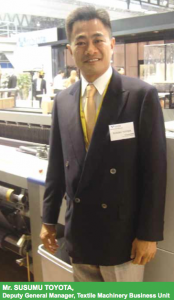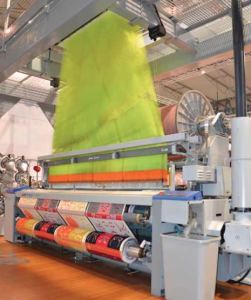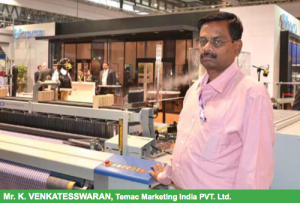 At ITMA 2011, the focus of Toyota Industries Corporation was on ‘energy saving’ and ‘environment friendliness’, such as equipping all of its looms with a new mechanism that further improves energy saving performance.
At ITMA 2011, the focus of Toyota Industries Corporation was on ‘energy saving’ and ‘environment friendliness’, such as equipping all of its looms with a new mechanism that further improves energy saving performance.
Mr. Susumu Toyota, Deputy General Manager, Textile Machinery Business Unit, says energy costs in Japan are pretty high for some time, promoting development of the technology.
In Toyota’s weaving machinery compressed air consumes the most electricity. “We have taken steps to minimize the volume of airflow and pressure of the air. We have reviewed the design of all components – nozzles, reeds and so on. We have achieved a 20% saving in air consumption in our weaving systems”.
With spinning systems becoming increasingly long and demanding larger motors, Toyota has developed an electric motor with lower power consumption. It has also optimized the vacuum system to save energy and achieved a 7% reduction in consumption, says Mr. Toyota.
Looking ahead, he says minimizing energy consumption will remain a key trend. “Energy costs are increasing worldwide. Also flexibility of our weaving machinery is key. Nowadays the economy is more globalised – there are so many different demands regarding fashion and customers have to react quickly to change and machines need to be flexible and able to produce and kind of style, with machine setting changed easily”.
“There is also demand for automation as labour costs become higher in countries such as India and China”, he adds.
 According to the Textile Machinery Business Unit, while the speeds of looms are approaching their limit, there are still many things to do and a long way to go as far as power saving on looms is concerned. In China and other emerging economies, the power situation is especially unstable, and the rising costs of labor and raw materials have increased production costs. Accordingly more people are attaching importance to the pursuit of energy saving, and this is likely to become a major subject in the future.
According to the Textile Machinery Business Unit, while the speeds of looms are approaching their limit, there are still many things to do and a long way to go as far as power saving on looms is concerned. In China and other emerging economies, the power situation is especially unstable, and the rising costs of labor and raw materials have increased production costs. Accordingly more people are attaching importance to the pursuit of energy saving, and this is likely to become a major subject in the future.
At ITMA 2011, Toyota Industries exhibited five JAT710 air-jet looms. This model boasts of its largest share in the world market. Since its launch into the market in 2003, the JAT710 has been maintaining its world’s No.1 position. The JAT710 inherits the JAT610’s development concept of “weaving the highest quality fabrics at the lowest cost” and has a number of improved features such as higher speed, lower vibration and lower energy consumption, along with the latest electronic technology that takes the weaving mill into a new dimension. It has a new Internet-capable color function panel, a full range of standard equipment and excellent potentials as the next generation of looms.
Together with the JAT 710, Toyota industries introduced a new fully improved model of its original “E-SHED” electronic shedding motion that features versatility. While it has the same advantages as the former model, productivity is approximately 20% higher. A newly developed liquid-cooled drive system enhances the ability to achieve high speed operation for even up to 16 frames, and further optimization of the drive mechanism reduces frame acceleration, which in turn reduces impact on the frames.
With “E-SHED”, the dwell and cross-timing of each frame can be set individually by electronic control, which can prevent slack warp ends and maintain clear shed-opening to achieve high running efficiency even with intricate fabric designs. Further, a newly developed ICSII (Initial Condition Setting II) provides the most suitable settings for dwell and cross timing according to the fabric variety. The liquid-cooled drive system, newly designed servo amplifier and optimized drive mechanism achieve 25 per cent greater energy savings than the former “E-SHED” model.
 At ITMA 2011, the company demonstrated “E-SHED”, promoting both flexibility and productivity.
At ITMA 2011, the company demonstrated “E-SHED”, promoting both flexibility and productivity.
In regard to ring spinning frames, Toyota Industries unveiled the successor to the RX 240 series. The new model has the unique “all-in-one” features of the RX 240, with the possibility to produce different kinds of yarns, including the standard type, compact yarn, yarn count ranging from coarse to fine counts, and fancy yarn, and it will newly feature energy saving and higher productivity with an ultra-long machine model Toyota Industries also expands flexibility towards the number of spindles. The new ring spinning frame will be offered with the world’s largest number of spindles per frames.
The series uses new technologies such as the company’s original spinning geometry, positive lifting and 10.5-inch color function panel, to realize high quality, high productivity, excellent operability and easy maintenance.
It is the first time in the world that a spinning machine maker will add a full-fledged fancy yarn device, which is easy to operate and can spin fancy yarns in all patterns.
Furthermore, the internet-capable TOYOTA MONITORING SYSTEM (TMS) provides reassurance and satisfaction in all aspects, such as the world’s highest level of space saving, energy saving and the shortest doffing time, and meets diversifying needs.